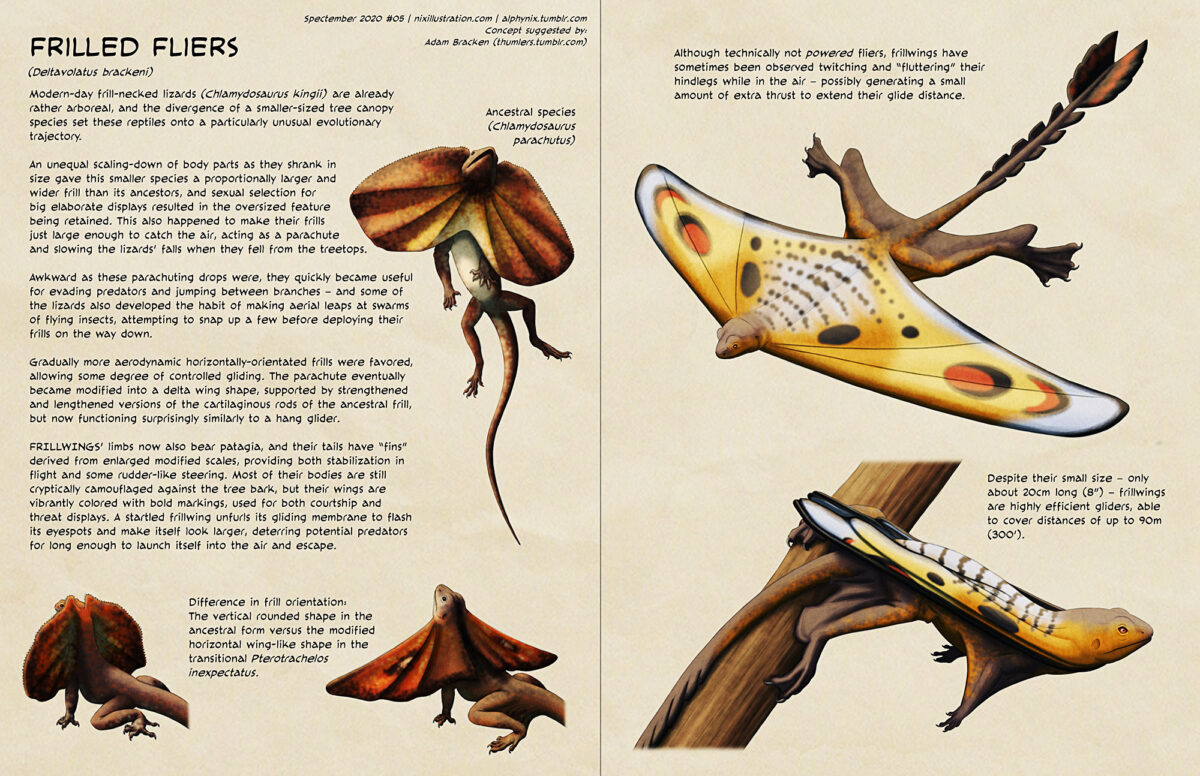Transcript for the text on the image under the cut:
PAGE 1
Spectember 2020 #05 | nixillustration.com | alphynix.tumblr.com
Concept suggested by:
Adam Bracken (thumlers.tumblr.com)
Frilled Fliers
(Deltavolatus brackeni)
Modern-day frill-necked lizards (Chlamydosaurus kingii) are already rather arboreal, and the divergence of a smaller-sized tree canopy species set these reptiles onto a particularly unusual evolutionary trajectory.
An unequal scaling-down of body parts as they shrank in size gave this smaller species a proportionally larger and wider frill than its ancestors, and sexual selection for big elaborate displays resulted in the oversized feature being retained. This also happened to make their frills just large enough to catch the air, acting as a parachute and slowing the lizards’ falls when they fell from the treetops.
[Image: a lizard falling through the air with its large neck frill spread out]
Ancestral species (Chlamydosaurus parachutus)
Awkward as these parachuting drops were, they quickly became useful for evading predators and jumping between branches – and some of the lizards also developed the habit of making aerial leaps at swarms of flying insects, attempting to snap up a few before deploying their frills on the way down.
Gradually more aerodynamic horizontally-orientated frills were favored, allowing some degree of controlled gliding. The parachute eventually became modified into a delta wing shape, supported by strengthened and lengthened versions of the cartilaginous rods of the ancestral frill, but now functioning surprisingly similarly to a hang glider.
FRILLWINGS’ limbs now also bear patagia, and their tails have “fins” derived from enlarged modified scales, providing both stabilization in flight and some rudder-like steering. Most of their bodies are still cryptically camouflaged against the tree bark, but their wings are vibrantly colored with bold markings, used for both courtship and threat displays. A startled frillwing unfurls its gliding membrane to flash its eyespots and make itself look larger, deterring potential predators for long enough to launch itself into the air and escape.
[Image: a comparison between a frill-necked lizard and an early frill-winged form, showing the difference in frill shape and orientation.]
Difference in frill orientation:
The vertical rounded shape in the ancestral form versus the modified horizontal wing-like shape in the transitional Pterotrachelos inexpectatus.
PAGE 2
[Image: a frillwing lizard in flight. Its colorful neck frill is shaped like a wide delta wing, similar to a hang glider, and it has a skin membrane between its outstretched hind legs. Its long thin tail is edged by several large fin-like scales.]
Although technically not powered fliers, frillwings have sometimes been observed twitching and “fluttering” their hindlegs while in the air – possibly generating a small amount of extra thrust to extend their glide distance.
[Image: a frillwing lizard clinging to a tree branch with its hind legs. Its wings are folded against its sides and it’s leaning off to one side, perhaps preparing to launch itself.]
Despite their small size – only about 20cm long (8”) – frillwings are highly efficient gliders, able to cover distances of up to 90m (300’).

